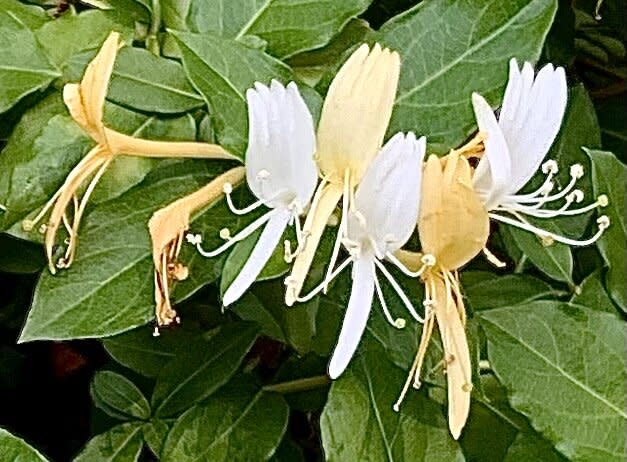Honeysuckle: The Weed We Hate To Love
There are plants in the garden you will smell before you see them. Some smell awful, like the atrocious Bradford pear. Some, on the other hand, smell wonderful. This is one, Japanese honeysuckle (Lonicera japonica). If any more luscious fragrance emanates from a flower, I have yet to whiff it.
Showy, tubular blossoms emerge in spring in the South, first white, then aging to yellow. Anyone who grew up with this vine knows that if you pick a bloom, pinch off the bottom tip, and pull the long pistil through the bloom, your tongue will be rewarded with a drop of sweet nectar.
Ah, but there's a price we pay for such sensual delight. This rampant vine, first brought from its native Japan to U.S. shores on Long Island, New York in 1806, absolutely loves the Eastern climate. Propagating by berries spread by birds as well as running rhizomes, it proceeded to conquer just about all of the woodlands, roadsides, wetlands, and disturbed areas east of the Mississippi River. It invaded Texas, Arkansas, Louisiana, and Missouri too. It's safe to say that if you came up with a list of the Five Worst Woody Weeds of the Eastern United States, Japanese honeysuckle would make the list.

Steve Bender
Like most vines, Japanese honeysuckle is programmed to grow and spread and never stop. If it has nothing to climb, it creeps along the ground until it does. When it does, it twines around it until it reaches the top and then starts looking for something else to climb. It will readily reach the top of a 100-foot-tall tree. If it twines around a young tree, it can literally strangle it to death. As it travels from tree to tree in the woods, it forms impenetrable thickets.
This is why no one in their right mind should ever – EVER – plant Japanese honeysuckle. If you discover it growing on your property, you should immediately kill it. If you don't, its roots and stems will entangle every plant you have, making eradication nearly impossible. Eradication is done by treating the plant according to label directions with translocatable herbicides, such as Roundup, Bioadvanced Brush Killer, Ortho Weed-B-Gon, or Spectracide Weed Stop, that the vine's leaves and stems absorb and carry down to the roots. Sorry, folks. Blue Dawn and vinegar won't work.
No matter what we do, however, Japanese honeysuckle is here to stay. I will always enjoy the sweetness of its blossoms – as long as they're in someone else's yard.
